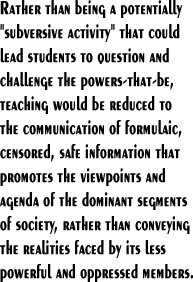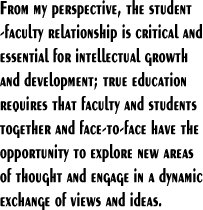0.1. As institutions of higher
education throughout the US and
abroad have adopted the corporate model,
"efficiency" and profit
have been emphasized, while students have
been redefined as
"customers", "consumers," and "clients."
In reality, what we are
currently witnessing, as the result of this
corporate paradigm,
is the destruction of American higher education.
University
presidents and administrators take on the
roles of Chief
Executive Officers, and business managers
have not supported
greater diversity or inclusiveness in academia,
whether in terms
of faculty or students. The bottom
line has become making money
rather than educating students or fostering
an environment
conducive to free intellectual inquiry and
development.
0.2. Although faculty often object to the
corporate paradigm,
because of what it does to our profession
and to us as
individuals, it is important to keep in mind
that ultimately it
is the students and their education who suffer
the most and have
the most to lose. There are three trends,
dictated by the
corporate approach, that profoundly affect
the quality of the
education our students receive.
The Profit Motive in Teaching
1.1. The requirement for profits under the
corporate model
frequently results in the cancellation of
classes when not enough
students (measured by administration formulas)
sign up. Thus
critically important courses may not be offered.
As the
corporate takeover has proceeded, minimum
enrollment numbers
have risen significantly. Thus a course
that in the past might have
been offered with four to five students may
now require a minimum
of ten students, or run the risk of being
cancelled. The needs
and desires of the students that have signed
up are simply
disregarded.
1.2. A corollary and frequent consequence
of this policy is
overcrowding of those courses which are offered,
so that students
receive much less individualized attention
from instructors.
Laboratory courses, particularly in the sciences,
are a good
example of what happens under these circumstances.
Rather than
creating new lab sections when the demand
for a lab course
increases, all too frequently the response
has been to keep the
same number of sections and stuff more students
into the lab. As
a result, a lab that twelve years ago had
a maximum of twelve to
fourteen students may suddenly be taught
with 24 or more
students. Quality of teaching inevitably
suffers but, in
addition, students may have to share equipment,
and there may not
even be enough room for all students to have
bench space and
suitable seating arrangements. The
profit motive mandates this
solution, since opening up new sections and
hiring additional
faculty to teach the extra sections is considered
too
"expensive."
1.3. Another manifestation of the profit motive
is that, at the
same time university administrators push
faculty to obtain more
external grant funds--with overhead going,
of course, to the
university, grants without overhead hardly
even count, so far as
most universities are concerned--they also
withdraw subsidies for
teaching and research. It is not unusual
now for faculty and
graduate students to have to pay for all
photocopying, phone
calls, and mailings out of their own pockets,
even when these
costs are related to their teaching and research.
Travel funds
that help defray the costs of attending professional
conferences
have been drastically cut back or completely
eliminated at many
universities. And subsidies for animal
research--e.g. to
maintain animal colonies used for research
by faculty, graduate,
and undergraduate students--have been eliminated
likewise. As a
result, teaching suffers, and certain types
of student research
opportunities are seriously curtailed or
eradicated.
Threats to Tenure
2.1. The current trend is for universities
to impose post-tenure
review or eliminate tenure altogether.
The party line is that
these measures emphasize "accountability"
and guarantee
excellence in education. Unfortunately,
the results are likely
to have highly detrimental effects on the
ability of faculty to
do quality teaching. Doing away with
tenure or implementing
post-tenure review will inevitably have a
chilling effect on
academic freedom. Although tenure is
a guarantee of job security
for faculty, academic freedom also protects
the student's right
to hear diverse and uncensored opinions from
their instructors.
The freedom to be exposed to different points
of view, and to
information on controversial topics, is essential
if students are
to have the freedom to think. Learning
to think, and to hear
views that may not accord with those of the
majority, is at the
heart of scholarship--it is precisely what
higher education is
all about. Threats to tenure and to
academic freedom are, at
their very core, about intimidating faculty,
thereby preventing
them from engaging students in meaningful
discussions about our
society, about social injustice, and about
the means to redress
societal problems. Rather than being
a potentially "subversive
activity" that could lead students to question
and challenge the
powers-that-be, teaching would be reduced
to the communication of
formulaic, censored, safe information that
promotes the
viewpoints and agenda of the dominant segments
of society, rather
than conveying the realities faced by its
less powerful and
oppressed members.
Distance Education
3.1. Distance education is promoted as the
cheapest way for
universities to offer courses and degrees,
but the reality is
quite different. Some universities
(if they can be called
universities at all) give all their courses
as "distance courses"
taught on the internet. Other, more
traditional universities
have turned to the internet to a lesser extent.
Students
enrolled in such courses never have to attend
a lecture, and
their interactions with the "instructor"
are completely through
the internet and e-mail. Instructor
and student may never meet,
or even see, one another. Some distance
courses offer limited
opportunities for discussions with a faculty
member and/or other
students in a chat-room type format, but
most long-distance
courses do not include this option.
As distance education
becomes increasingly common, it will be possible
for a student to
go through an entire four year course of
study without ever
having any meaningful contact with a faculty
member and other
students. Hands-on experiences, such
as are necessary in many
laboratory settings, will be impossible.
3.2. One is left with the question: "Is this
education?" I
suggest that long distance courses, at best,
allow students to
memorize a lot of facts. Memorization,
however, is not
education. From my perspective, the
student-faculty relationship
is critical and essential for intellectual
growth and development;
true education requires that faculty and
students together and face-to-face have the opportunity to explore new
areas of
thought and engage in a dynamic exchange
of views and ideas.
Seen from this perspective, cyber-education
is an oxymoron.
4. In summary, the current corporate takeover
of higher education
brings to mind the story of Faust.
In contrast to Faust, who
sold his soul to the devil for knowledge,
many current university
administrators and managers are in the process
of selling the
soul of knowledge and higher education for
"big bucks"; and in
the process both faculty and students are
being damned to hell.
The pretense and pretext proclaim that the
corporate paradigm is
about efficiency and guaranteeing high quality
performance of
faculty. The reality is that it is
being used to co-opt faculty
into creating "products"--the students--who
will be apologists
for the powerful, and who will generate more
profits by taking
their place as unthinking cogs in the wheels
of our society's
corporate machinery.
Zuleyma Tang-Martinez (azarembka@compuserve.com)
is Professor of
Biology and Women's Studies, University of
Missouri, St. Louis,
and Vice-President of the AAUP chapter at
UMSL. |


|
![]()
